Banbury Road
Banbury Road[1] is a major arterial road in Oxford, England, running from St Giles' at the south end, north towards Banbury through the leafy suburb of North Oxford and Summertown, with its local shopping centre. Parallel and to the west is the Woodstock Road, which it meets at the junction with St Giles'. To the north, Banbury Road meets the Oxford Ring Road at a roundabout. The road is designated the A4165 (which continues for a short distance as Oxford Road to Kidlington). Prior to the building of the M40 motorway extension in 1990, the road formed part of the A423 from Maidenhead to Coventry.
 | |
|---|---|
.jpg.webp) | |
| Route information | |
| Length | 3.7 mi (6.0 km) |
| Major junctions | |
| South end | Oxford |
| North end | Near Kidlington |
| Location | |
| Country | United Kingdom |
| Constituent country | England |
| Road network | |
Buildings
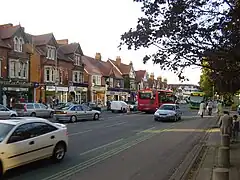

The former Mathematical Institute of Oxford University is at the lower end of the road on the east side. Opposite Keble Road is St Giles' Church, built in 1120 and consecrated in 1200. Further north are the Denys Wilkinson Building (astrophysics) and the prominent 1960s Thom Building of the Engineering Science department.
One of the university's former women's colleges, St Anne's College backs onto Banbury Road and another, St Hugh's College, flanks the road further up. Kellogg College and Wycliffe Hall, which are also part of the university are situated on Banbury Road, near to the junction with Bevington Road. The Independent Sixth Form of d'Overbroeck's College is housed in both the Swan Building at 111 and the adjacent number 113 which was, by the turn of the 20th century, occupied by a Mr R. Lamb Abbott MA who advertised for students to take instruction in "a course of lectures" over four weeks or so to enable them to sit their responsions and thus matriculate at the university.[3]
Wychwood School, an independent girls' school, is at 74 Banbury Road. Established in 1897 as Miss Batty's School for the daughters of Oxford dons, from 1898 to 1907, the school was housed at 77 Banbury Road – a "charming Regency house" – where residents Miss A.S. Batty and Miss Margaret Lee MA taught a handful of day girls. Miss Lee would later acquire ownership of number 77. The school at that time also provided accommodation for young women sitting examinations who were members of the Society of Oxford Home Students – later St Anne's College, Oxford where Miss Lee tutored from 1913 to 1936. 77 Banbury Road was religious in nature: Miss Batty had an academic interest in religious matters and Miss Lee was the granddaughter of an Anglican vicar.[4][5][6]
Banbury Road Medical Centre is a National Health Service facility at 172 Banbury Road.[7]
BBC Oxford is also based on Banbury Road and is home to the local televised news output and BBC Radio Oxford. In early 1970 the BBC Oxford studios were actually located further down at 242–254 Banbury Road (now a branch of Marks & Spencer), but were later moved to 269 in 1989 as local media services within BBC Oxford expanded.
People
Famous residents include the lexicographer James Murray who produced the first Oxford English Dictionary (a blue plaque now marks the site) and the zoologist Desmond Morris, author of The Naked Ape.
The artist Paul Nash (1889–1946) lived at 106 Banbury Road, marked with an Oxfordshire Blue Plaque.[8][9]
Jesse Elliston, the proprietor of what became Oxford's leading department store, Elliston & Cavell, died in the Banbury Road in 1853 at the age of only 47.
Dame Honor Fell DBE, FRS (1900–1986) studied at Wychwood School and this is commemorated with a blue plaque from the Society of Biology, installed in 2015.[10]
Christopher Strachey (1916–1975) founded and led the Programming Research Group (part of Oxford University) from 1965 until his untimely death, at 45 Banbury Road.[11] From 1977, the PRG was then led by Tony Hoare, located here until 1984.
Adjoining roads in North Oxford
- Bardwell Road
- Beech Croft Road
- Belbroughton Road
- Bevington Road
- Canterbury Road
- Five Mile Drive
- Keble Road
- Lathbury Road
- Linton Road
- Lonsdale Road
- Marston Ferry Road
- Moreton Road
- Norham Gardens
- Norham Road
- North Parade
- Park Town
- Parks Road
- Rawlinson Road
- South Parade
- Staverton Road
- St Giles'
- St Margaret's Road
- Victoria Road
- Woodstock Road
Gallery
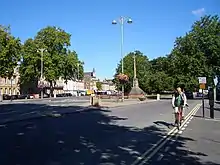 The southern end of Banbury Road (right) and Woodstock Road (left) from the north end of St Giles'.
The southern end of Banbury Road (right) and Woodstock Road (left) from the north end of St Giles'. The Denys Wilkinson Building from the Banbury Road on the corner with Keble Road, looking north with the Thom Building in the background.
The Denys Wilkinson Building from the Banbury Road on the corner with Keble Road, looking north with the Thom Building in the background.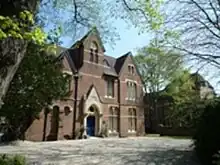 Kellogg College at 62 Banbury Road.
Kellogg College at 62 Banbury Road. Offices on Banbury Road in Summertown.
Offices on Banbury Road in Summertown.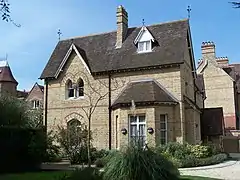 37 Banbury Road, St Anne's College, a typical Gothic North Oxford house, designed by Frederick Codd in 1866.[12]
37 Banbury Road, St Anne's College, a typical Gothic North Oxford house, designed by Frederick Codd in 1866.[12]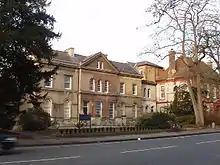 Oxford University Computing Services building on Banbury Road.
Oxford University Computing Services building on Banbury Road.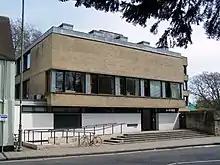 The former Mathematical Institute, near the southern end of Banbury Road.
The former Mathematical Institute, near the southern end of Banbury Road. Wychwood School for Girls at 74 Banbury Road.
Wychwood School for Girls at 74 Banbury Road.
See also
- Acland Hospital
- Norham Manor estate
References
- "Banbury Road". UK: Oxford History. Retrieved 21 September 2014.
- Blue Plaque marks home of first OED Editor, Blueprint: The newsletter of the University of Oxford, 21 November 2002.
- "The Saturday Review of Politics, Literature, Science and Art". Google books. 1893. Retrieved 13 April 2022.
- "London's National Portrait Gallery – Miss Lee". NPG – London. Retrieved 13 April 2021.
By this time [1896] Margaret had made a plan to take rooms in Oxford for both of them and help Miss [A.S.] Batty to establish a school for girls. This plan was successfully carried out. Margaret and Miss Batty established themselves at 41 Banbury Road and in January I897 a few pupils, daughters of Oxford dons, formed a nucleus of what was later to become Wychwood School. The little school flourished, pupils flocked in, more rooms in the house were added till, in 1898, the lease and later the ownership of 77 Banbury Road were acquired. Miss Batty's health improved marvellously and her wonderful power as a teacher began to be felt. 77 Banbury Road, a charming Regency house with a little garden stretching along North Parade, swarmed with school-children by day, and there were usually a few young women living there while reading for various examinations. The school soon overflowed and moved to Park Crescent in 1906...To return to Margaret's academic career at Oxford: she held her teaching appointments under the Association for the Education of Women and in 1913 was appointed Tutor to the Oxford Home Students (later St. Anne's College) and she held this until she retired in 1936...MARGARET LUCY LEE was born on 14 July 1871, the eldest child of Thomas William Lee, son of Joseph Lee, of Redbrook House, Flint, and Margaret Anne, daughter of Rev. C. H. Lyon, of Glen Ogil, the seat for 500 years of the cadet branch of the Bowes-Lyons of Glamis Castle.
- Religions of the lower culture. Section II. Religions of China and Japan. Section III. Religions of the Egyptians. Section IV. Religions of the Semites. 1908. Retrieved 13 February 2022.
Miss Batty, 77 Banbury Road, Oxford – page vi
- Kloester, J. (2013). Georgette Heyer: Biography of a Bestseller. Arrow Books. p. 42. ISBN 9780434020713. Retrieved 12 April 2022.
Later, Carola and Joanna both went to Miss Batty's School for the daughters of Oxford dons (later called the Wychwood School) where they created a ...
- "Banbury Road Medical Centre". UK: Oxfordshire NHS.
- "Paul Nash (1889–1946) Artist, 106 Banbury Road, Oxford". UK: Oxfordshire Blue Plaques Board. Retrieved 21 September 2014.
- "Paul Nash 1889–1946 artist lived here 1940–1946". Open Plaques. Retrieved 21 September 2014.
- "Oxford Inscriptions: Dame Honor Fell, Wychwood School". History on the streets of Oxford. UK. Retrieved 5 April 2020.
- "Expenditure for house occupied by the Programming Research Group, 1966–1968". Bodleian Archives & Manuscripts. UK: Bodleian Library, University of Oxford. MS. Eng. misc. b. 255/B.25. Retrieved 7 September 2020.
- Hinchcliffe, p. 217.
Bibliography
- Hinchcliffe, Tanis, North Oxford. New Haven & London: Yale University Press, 1992. ISBN 0-300-05184-0.